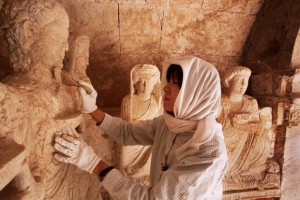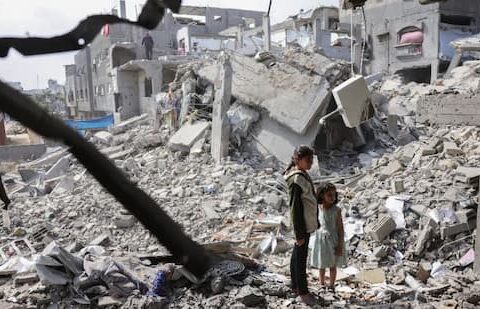Let’s please take a moment to pause in respect for Mr Khaled el-Asaad, who has been tortured and beheaded by the foreign-created thugs and criminals of ISIL or ‘Daesh’ in Syria.
The 82 year-old Syrian head of antiquities, dubbed the ‘Howard Carter’ of Palmyra, had worked in the historic World Heritage city of Palmyra for over 50 years, his knowledge and expertise of the city and its vast antiquities having been unmatched.
His family were reportedly told two days ago that the 82 year-old had been executed by the ISIL militants who had captured the city from Syrian government forces in May.
The elderly scholar is said to have been interrogated and tortured for over a month by the militants, who had been trying to get him to reveal where a number of priceless antiquities have been hidden.
Images shared on social media by soulless supporters of the ‘Islamic State’ showed the mutilated remains of Mr Asaad, with his severed head placed on the floor between his feet. I’ve seen the image, but it’s too horrific to share.
His body was then taken to one of Palmyra’s legendary archaeological sites and hung from one of the ancient Roman columns for everyone to see.
ISIL/Daesh’s capture of Palmyra in May has left archaeological, cultural and World Heritage experts fearful of the city’s vast cultural/historic treasures being destroyed or vandalised by the multi-national terrorists. The capture of Palmyra had also been a highly worrying indication of how weakened the Syrian government and army had become, unable to hold onto such an important location when it came under attack from the world’s wealthiest, best-funded terrorist organisation.
Even as early as mid-May some 400 people were reported to have already been killed by the IS militants in Palmyra.
In terms of this general, sustained assault on the cultural heritage of both Syria and Iraq, I already posted at length on this subject, including Palmyra, but also on some of the destruction of historic sites going back to the 2003 US-led invasion of Iraq (see here).
But it is worth reiterating again that, in many cases, these aren’t Iraqis or Syrians destroying their own culture – but scores of foreign thugs and vandals.
The ranks of ISIS/ISIL are made up of young men from all over the world, particularly Europe. In many cases these are French, British, Scandinavian and other young men reveling in the callous decimation of two countries’ rich history and culture. One must wonder, for that matter, whether Khaled al-Asaad’s cold-blooded murderers were even Syrians or whether they were British or European recruits – because, let’s be clear, there are a LOT of British and European ISIL terrorists rampaging in Syria and Iraq and killing Syrians and Iraqis. NATO-member Turkey has been letting scores of such recruits cross into Syria via its border for almost four years now.
In terms of the plundering of Syrian and Iraqi historic sites and antiquities, which is such an enormous source of funding for ISIL/Daesh, this isn’t solely a crime of the thugs and vandals themselves, but is also on the hands of their wealthy foreign clients.
This, for example, is a particularly eye-opening story about how Syrian antiquities looted by ISIL are finding there way into London shops. In short, if wealthy buyers in Britain, Europe and wherever else weren’t willing to pay ISIL plunderers so much money for their stolen artifacts, this business of black market antiquities wouldn’t be thriving and the Islamic State would lose a HUGE amount of its funding.
Because it’s quite clear that, aside from the black-market oil dealing, the trade in stolen antiquities is a massive portion of the terrorists’ wealth.

Mr Khaled al-Assad is a hero. Not just a hero of Syria, nor just of Palmyra, but of culture itself, and of history, and of World Heritage.
He has lost his life trying to preserve and protect his country’s history, culture and identity against the 4-years-and-counting campaign of destruction and death conducted by the scores of foreign-imported militants and terrorists.
The image at the top of the page is a 2002 picture of Khaled al-Asaad in front of a rare sarcophagus from Palmyra dating from the first century (Photograph by Marc Deville/Gamma-Rapho and via Getty Images).
This here is a fitting tribute paid in The Guardian to the 82 year-old Syrian scholar by his friend, the keeper of the Middle East department at the British Museum.
In general, we can only reiterate the words of Kino Gabriel, one of the leaders of the Syriac Military Council, who summarised the situation aptly some months ago, saying simply that “the birthplace of human civilisation is being destroyed.”
And the late Khaled al-Asaad was one of its great guardians.





Please share this video to remember Dr. Khalid Al-Asaad. From documentary footage:
https://youtu.be/Ewoyijs08Bs
In Memoriam +Dr Khalid Al Asaad+ extrait doc 2014
Done, Nahor Guëttam. Thank you. I’ll share it on Facebook and Social Media too.
Very sad!
https://blogsforjustice.wordpress.com/2015/08/22/turkey-usa-and-israel-air-raids-on-syria/
Reblogged this on The Missal.